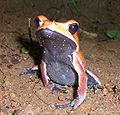- Bicolored Frog
-
Bicolored Frog 
Male in breeding colours Conservation status Scientific classification Kingdom: Animalia Phylum: Chordata Class: Amphibia Order: Anura Family: Ranidae Genus: Clinotarsus Species: C. curtipes Binomial name Clinotarsus curtipes
(Jerdon, 1854)Synonyms Rana curtipes Jerdon, 1854
The Bicolored Frog (Clinotarsus curtipes) is a species of frog found in the Western Ghats of India. This frog has a very toad like disposition. The tadpoles of the species are black and form dense and compact schools in slow moving streams in forested areas.
Description
The Bicolored Frog's vomerine teeth scarcely developed, sometimes indistinct. The teeth are in two slightly oblique series on a level with the hind edge of the choanae. Its head large; snout short, rounded, with well-marked canthus rostralis and concave loreal region ; nostril nearer to the end of the snout than to the eye; interorbital space broader than the upper eyelid; tympanum distinct, nearly as large as the eye. Fingers moderate, first extending beyond second; toes short, nearly entirely webbed; tips of fingers and toes swollen or dilated into very small disks; subarticular tubercles much developed; inner metatarsal tubercle small, oval, blunt; a rather large, flat tubercle at the base of the fourth toe; no tarsal fold. The tibio-tarsal articulation reaches the eye. Skin finely granular above; a moderately prominent, rather narrow glandular lateral fold ; another told behind the tympanum down to the shoulder. Clinotarsus curtipes is greyish or brown above, with or without blackish dots; lateral fold lighter, edged with black; a blackish oblique spot or band below the eye; upper lip with a blackish margin; limbs dark purplish brown, without cross bands; light brown beneath, the throat sometimes dark brown. Male with an internal subgular vocal sac.[1][2]
The spot patterns on the backs are often distinctive enough to use for population estimation using capture and recapture techniques. Use of this technique in the Bisale Reserve Forest in Kodagu during January 1999-July 2001 gave a population density estimate of 0.08-0.1 frogs per square metre.[3]
Adults may occasionally feign death to escape predators.[4]
The tadpoles are large and form shoals in slow moving streams.[5]
-
A pair in amplexus
Status
This species is listed as Near Threatened on the IUCN Red List.[6]
References
- ^ Boulenger, G. A. (1890) The Fauna of British India, Including Ceylon and Burma: Reptilia and Batrachia.
- ^ Desai R.N. and Pancharatna K. 2003. Rana curtipes coloration Herpetol. Rev 34(1), 53-54.
- ^ Krishna, S. N., Krishna S. B. and K.K. Vijaylaxmi. (2005) Dorsal spot pattern as unique markers to estimate the population size of Rana curtipes. J. Bombay Nat. Hist. Soc. 102(1):16-18
- ^ N. P. Gramapurohit, B. A. Shanbhag and S. K. Saidapur (2001) Rana curtipes (bicolored frog). Death feigning. Herpetological Review 32(2):103
- ^ Ningappa C. Hiragond, Bhagyashri A. Shanbhag, Srinivas K. Saidapur 2001. Description of the Tadpole of a Stream Breeding Frog, Rana curtipes. Journal of Herpetology, 35(1):pp. 166-168 doi:10.2307/1566044
- ^ Biju et al. (2004). Rana curtipes. 2006. IUCN Red List of Threatened Species. IUCN 2006. www.iucnredlist.org. Retrieved on 11 May 2006. Database entry includes a range map and justification for why this species is near threatened
Categories:- IUCN Red List near threatened species
- Clinotarsus
- Frogs of India
Wikimedia Foundation. 2010.






